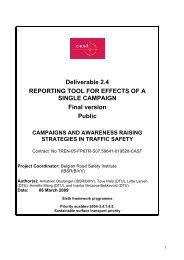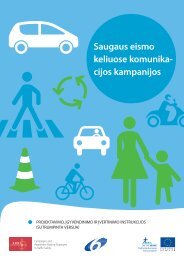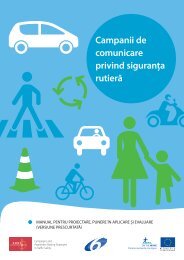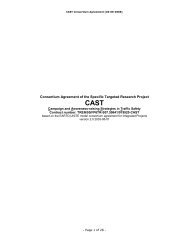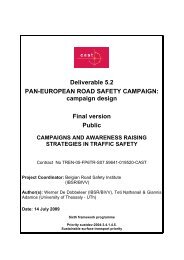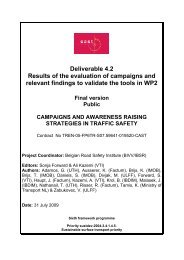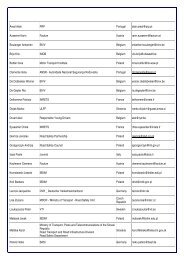Deliverable D 1.3 RESULTS OF META-ANALYSIS ... - cast-eu.org
Deliverable D 1.3 RESULTS OF META-ANALYSIS ... - cast-eu.org
Deliverable D 1.3 RESULTS OF META-ANALYSIS ... - cast-eu.org
Create successful ePaper yourself
Turn your PDF publications into a flip-book with our unique Google optimized e-Paper software.
Campaigns and awareness raising strategies in traffic safety — <strong>Deliverable</strong> D-1.1candidate models for meta-regression analysis does not mean they are notmeaningful influences on campaign effect.Consider limitations of meta-analysis when interpreting resultsA further reason for including subgroup analyses in this report is as acomplement to the meta-regression data, which is generated on the basis ofseveral important assumptions. We have attempted to delineate theoreticaland methodological limitations throughout this report and while it is not ouraim to repeat them here, willingness to accept the conclusions we drawshould depend on the level of agreement with decisions we have made andassumptions we have taken during treatment of the data.In this vein, it is worth outlining the breadth of the database of road safetycampaign evaluations itself. It contains 433 effects, including 133 seatbelt useeffects and 115 accident effects. Most of the studies are drawn from scientificjournals and institute reports, and they summarize campaigns carried outacross the last 30 years, mainly in Europe and USA. The most commoncampaign themes in the database are seatbelts (34 per cent of effects forseatbelt campaigns), drink-driving (24 per cent) and speeding (15 per cent).The types of campaign tending to use accidents as a measure of campaigneffect are drink-driving (36 per cent of accident effects are for drink-drivecampaigns) and speeding (22 per cent) campaigns. There is some evidencethat different countries tend to focus on certain themes; in particular manyseatbelt-themed campaigns are American (69 per cent) and many drink-drivecampaigns Australian (43 per cent). The campaigns cover a wide range scopeand duration, from less than one hundred to over a million people and from 1day to several years. In accepting the conclusions drawn from this data, onemust assume that we can learn from the regularities apparent amongst suchdisparate information.Evaluation studies should include more informationFinally, we would like to recommend improvements to reduce the number ofthose limitations that have their roots in the original campaign evaluationstudies.First, we are unable to say anything about the effects of campaigns on theintensity of safety outcomes such as speed, because such measures werefew and far between. It would be interesting to evaluate known speeds for aknown number of observations, but studies either state average recordedspeed in the absence of other information, or give percentage speeding (i.e.frequency not intensity of behaviour). In this study we decided to focus on themore available percentage speeding measure, which does not tell us anythingabout how much speeds have slowed.In many cases it was not clear whether a campaign is part of an ongoingprogramme or not. While we tried to avoid including campaigns that followedon from recent campaigns that could still be having effects, it was not alwayseasy to determine the situation from the available information. Clearerinformation about the history of campaigns carried out in the study area wouldhelp.117



